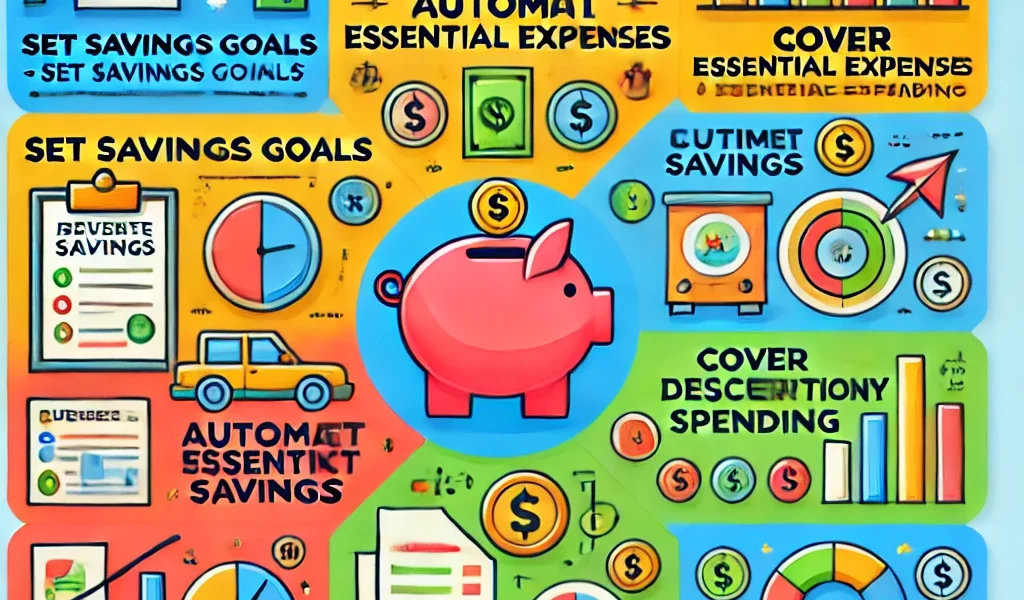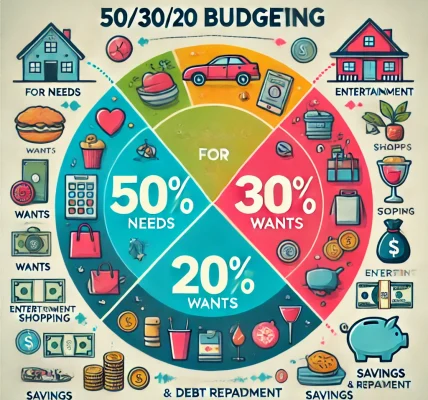📚 Introduction:
When it comes to personal finance, most people follow the traditional approach of budgeting: allocate money to expenses first and then save whatever remains. But what if you flipped the script and prioritized savings before anything else?
Reverse budgeting is an innovative strategy that focuses on securing your savings goals before allocating funds for discretionary spending. This approach ensures that you meet your long-term financial objectives without falling into the trap of overspending.
In this guide, we’ll explore how reverse budgeting works, its benefits, and a step-by-step process to implement it successfully.
🎯 What is Reverse Budgeting?
Reverse budgeting, also known as paying yourself first, involves setting aside a portion of your income for savings and investments before covering other expenses. Unlike traditional budgeting, where spending takes precedence, reverse budgeting ensures that saving becomes a non-negotiable priority.
✅ Key Principle:
- Instead of spending first and saving later, you save first and spend what’s left.
✅ Primary Goal:
- Secure long-term financial goals such as retirement, emergency funds, or investments.
📝 How Does Reverse Budgeting Work?
- Set Savings Goals:
Define specific short-term and long-term financial goals. - Automate Savings:
Allocate a fixed percentage of your income to savings and investments immediately after receiving your paycheck. - Cover Necessary Expenses:
Use the remaining amount to cover essential expenses like rent, groceries, and utilities. - Limit Discretionary Spending:
Spend what’s left on entertainment and non-essential items.
📈 Why Reverse Budgeting is Effective
- Promotes Financial Discipline:
By automating savings, you eliminate the temptation to overspend. - Prioritizes Long-Term Goals:
Ensures that your future financial security takes precedence over short-term desires. - Reduces Stress and Anxiety:
Knowing that your savings are secure brings peace of mind. - Prevents Lifestyle Inflation:
As income increases, reverse budgeting prevents unnecessary spending.
📊 Traditional Budgeting vs. Reverse Budgeting
| Feature | Traditional Budgeting | Reverse Budgeting |
|---|---|---|
| Priority | Expenses first, savings last | Savings first, expenses later |
| Flexibility | Higher flexibility | Lower flexibility |
| Goal-Focused | Less focus on future goals | Emphasizes long-term goals |
| Risk of Overspending | Higher | Lower |
| Stress Management | Potential financial anxiety | Peace of mind |
🎯 Step-by-Step Guide to Implement Reverse Budgeting
📝 Step 1: Define Your Savings Goals
Identify both short-term and long-term financial objectives.
✅ Short-Term Goals:
- Emergency fund
- Vacation or major purchase
✅ Long-Term Goals:
- Retirement corpus
- Buying a house
- Child’s education
🚨 Pro Tip:
Be specific with your goals and assign target amounts and timelines.
📝 Step 2: Calculate the Savings Percentage
Decide the percentage of your income that you want to allocate to savings.
- Recommended Range: 20-30% of your income
- Adjust based on your income level and financial commitments.
✅ Example:
If your monthly income is ₹50,000 and you want to save 25%, allocate ₹12,500 to your savings automatically.
📝 Step 3: Automate Your Savings
To ensure consistency, set up automatic transfers to your savings or investment accounts.
✅ Best Practices:
- Use standing instructions to transfer funds to your SIP, PPF, or mutual funds.
- Allocate money to high-yield savings accounts or fixed deposits (FDs).
🚨 Pro Tip:
Automate transfers immediately after salary credit to avoid spending the amount.
📝 Step 4: Cover Essential Expenses
After allocating savings, use the remaining balance to cover necessary expenses such as:
- Rent or mortgage payments
- Utilities and groceries
- Transportation and healthcare
✅ Recommended Formula: Income−Savings=AmountAvailableforExpensesIncome – Savings = Amount Available for ExpensesIncome−Savings=AmountAvailableforExpenses
📝 Step 5: Limit Discretionary Spending
Discretionary expenses should be the last priority in reverse budgeting.
- Entertainment, dining out, and non-essential shopping should be restricted to what’s left after saving and covering essentials.
🚨 Pro Tip:
Use the 50/30/20 rule to maintain balance:
- 50% for needs
- 30% for wants
- 20% for savings and investments
📝 Step 6: Monitor and Adjust Periodically
Regularly review your budget and adjust savings percentages if your income changes or your goals evolve.
- Review Interval: Every 3-6 months to stay aligned with your financial objectives.
✅ Track Using Tools:
- Mint
- YNAB (You Need a Budget)
- PocketGuard
💡 Pro Strategies to Maximize Reverse Budgeting Success
🎯 1. Set Multiple Savings Buckets
Divide your savings into multiple buckets for different goals:
- Emergency Fund: For unexpected expenses.
- Retirement Savings: Long-term investments like PPF, NPS, or SIPs.
- Major Purchases: Car, house, or vacation fund.
🎯 2. Increase Savings with Income Growth
As your income increases, allocate a higher percentage to savings without increasing discretionary spending.
🎯 3. Pay Off High-Interest Debt First
Prioritize paying off high-interest debt to avoid eroding your savings through interest payments.
🎯 4. Utilize Employer Benefits
Maximize contributions to employer-sponsored retirement accounts or provident funds.
🎯 5. Set a Savings Buffer for Emergencies
Ensure that 3-6 months’ worth of living expenses are kept aside as an emergency buffer.
🚨 Common Mistakes to Avoid with Reverse Budgeting
- Underestimating Expenses:
Failing to account for all fixed expenses may leave insufficient funds. - Ignoring Inflation Adjustments:
Inflation erodes purchasing power, requiring periodic savings adjustments. - Overlooking Debt Payments:
High-interest debts should be tackled to prevent interest from negating savings growth. - Lack of Review and Monitoring:
Neglecting to revisit your budget periodically can lead to inefficiencies.
📈 How to Measure Success with Reverse Budgeting
✅ Key Metrics to Track:
- Percentage of income saved monthly.
- Progress toward achieving financial goals.
- Reduction in discretionary spending.
✅ Financial Tools for Tracking:
- Mint: Tracks spending and categorizes expenses.
- YNAB: Helps automate and allocate funds.
- Personal Capital: Monitors investments and financial goals.
🎉 Conclusion: Prioritize Your Financial Future with Reverse Budgeting
Reverse budgeting is a powerful approach that shifts your focus from spending to saving, ensuring that you prioritize your financial goals. By automating savings, managing expenses effectively, and limiting discretionary spending, you can build long-term wealth and financial security. Adopting this strategy will not only prevent lifestyle inflation but also help you stay on track with your goals.



